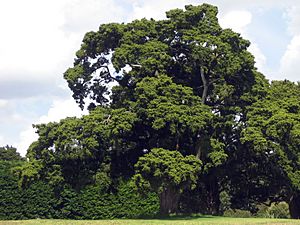Totara facts for kids
Quick facts for kids Tōtara |
|
|---|---|
 |
|
| Conservation status | |
| Scientific classification | |
| Genus: |
Podocarpus
|
| Species: |
totara
|
The Podocarpus totara, often called tōtara (from the Māori language), is a special type of tree. It is found only in New Zealand. This tree grows across the North Island and the northeastern part of the South Island. You can find it in forests from lowlands up to mountains, usually below 600 meters high. Tōtara trees like soil that is rich and drains water well.
Contents
What Does a Tōtara Tree Look Like?
The tōtara is a medium to large tree. It grows slowly, usually reaching about 20 to 25 meters tall. Some can even grow as tall as 35 meters! These trees are known for living a very long time and having thick trunks.
Bark and Leaves
The tree's bark peels off in thin, papery flakes. It can be purplish or golden-brown. Its leaves are dull-green and feel stiff and leathery. They are shaped like needles and are about 2 centimeters long.
Cones and Seeds
Instead of typical cones, the tōtara produces unique, fleshy structures. These look like berries and are bright red when they are ripe. Inside, they hold one or two round seeds.
Giant Tōtara Trees
The biggest known living tōtara is called the Pouakani Tree. It is near Pureora in the central North Island. This amazing tree is over 35 meters tall. Its trunk is almost 4 meters wide! Forest workers found it in 1950. Other very tall tōtara trees, some over 40 meters high, grow in Whirinaki Forest.
Tōtara trees often grow back on farmland. This is because farm animals do not like to eat them.
Growing Tōtara Trees
Tōtara trees are quite easy to grow. They can sprout from fresh seeds or from cuttings. People have planted tōtara trees in other countries, like Scotland in the United Kingdom.
Garden Varieties
There are also special types of tōtara grown for gardens. Some have yellow-gold leaves that get darker in winter, like 'Albany Gold' and 'Aurea'. 'Pendula' has branches that hang down, especially when the tree is young. 'Silver Falls' also has hanging branches but with cream-colored edges on its leaves. 'Matapouri Blue' grows in a cone shape and has bluish-green leaves.
How People Use Tōtara Wood
The wood of the tōtara tree is very strong and straight. It is also very good at resisting rot, especially the wood from the center of the tree. Because it lasts so long, tōtara wood was often used for fence posts, house foundations, and railway tracks.
Māori Carving and Waka
Tōtara wood was also very important for Māori carving. It was the main wood used for making waka (traditional Māori canoes). This was because tōtara wood is lighter than some other woods. It also grows in long, straight pieces. The natural oils in the wood help stop it from rotting.
Māori carvers could drill holes near the edges of tōtara timber without it splitting. For very large waka, three or more sections of wood were tied together with flax rope. It could take at least a year to make a tōtara waka using stone tools.
Other Uses
The bark from tōtara trees was used to cover and protect traditional pōhā bags. These bags were used to store food.
Images for kids
See also
 In Spanish: Podocarpus totara para niños
In Spanish: Podocarpus totara para niños




